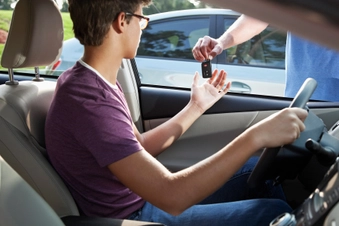Tips for Kids and Teens with Type 1 Diabetes

Protect and Empower Your Child With T1
A diagnosis of type 1 diabetes may be daunting. You and your child have a lot of adjustments to make as you both learn to manage a disease that’s for life. As a parent, your main goal is to keep them safe. But you also want to give them the tools and confidence they need to handle their own health care and enjoy life like any other kid. These tips may help.

Understand the Symptoms
You and your child will test their blood sugar throughout the day on a schedule their doctor recommends. But you’ll also need to watch for warning signs that their level is too high or too low. Symptoms can vary but may include weakness, irritability, dizziness, and headache. Teach your child to listen to their body so you can act before it becomes an emergency. Anyone else who takes care of your child should know the symptoms too.

Get Comfortable With the Treatment
When your child is younger, you’ll be the one to check their blood glucose levels and give them insulin. But as they get older, they’ll take on this responsibility. Your child’s doctor can suggest age-appropriate ways to include them in their care. Teens might start to manage their own treatment right from the diagnosis. But it’s important for you to also understand the processes and the schedule so you can support them.

Build Your Care Team Relationship
Type 1 diabetes means lots of doctor visits, so you’ll want to find a care team that makes you and your child feel comfortable and confident. Don’t be shy about doctor-shopping. Not everyone is a good fit. As your child gets older, the doctor will probably ask you to let them speak privately for at least some of the visit. Don’t be thrown. You’ll still get their test results, and you can follow up with the doctor if you need to.

Watch for Emotional Warning Signs
Life with type 1 diabetes can feel overwhelming. It’s easy to get burned out and discouraged. There’s even a name for it: “diabetes distress.” Encourage your child to express what they’re feeling. It may help them to talk with a counselor or therapist. Watch for signs of depression. In children this can be things like clinginess, irritability, and trouble in school.

Seek Support for Your Child
You may have a great relationship with your child. But sometimes it’s just better if they talk with someone who’s been there. Check with your child’s doctor about type 1 diabetes support groups in your area, or look for one online. Their school may be able to connect them with other kids living with the disease. And several organizations offer summer camps just for kids with type 1 diabetes.

Work With Their School
Set up a meeting with school administrators to make a plan to manage your child’s testing and medication needs. This will also ensure that everyone’s ready in case of an emergency. Include your child in the process. Make sure that all teachers understand that blood sugar highs and lows can affect behavior and focus. Your child may need accommodations, like extra time or breaks during tests.

Be Smart About Sports
Sports can be a normal part of childhood for kids with type 1 diabetes, as long as they’re mindful of how exercise affects their blood sugar levels. Some kinds of physical activity can lower blood glucose levels, while others can raise them. The key is to test often, especially when they’re starting a new sport or workout routine, to learn how their body reacts. Then you can adjust their eating schedule and insulin doses as needed.

Ground the Helicopter
It can be hard not to hover. But if you do everything for your child, they may get the message that they’re not capable of managing on their own. Of course, things like a sleepover will seem scary at first. You can reassure yourself by talking to the other parents or remotely tracking your child’s blood glucose levels. Let them know that freedom comes with the responsibility to stick to their treatment plan even when you aren’t around.

Prepare for Puberty
You may have a good handle on your child’s diabetes care when they’re younger. Then puberty begins and everything changes. Surging hormones raise blood sugar levels. Plus, your child is growing fast and eating more. Be prepared to have to increase their insulin dose. If your child has periods, they should learn to test more often around those times to find patterns and adjust their treatment on those days.

Set Ground Rules for Driving
Type 1 diabetes adds another level of concern to what’s already a nerve-wracking milestone for parents: giving your child the car keys. Be very clear that they must test before they drive for their own safety and that of everyone else on the road. They should know to pull over if they feel symptoms and stop to check their levels at set times during a long trip. Keep the glove compartment stocked with snacks and emergency supplies.

Educate About Alcohol
The alcohol conversation can be touchy for any parent. But it’s vital when your teen has type 1 diabetes because of how alcohol impacts blood sugar. When your liver is processing alcohol, it can’t help to manage your blood glucose level, which can then drop dangerously low. The crash may come hours after you’ve been drinking, and emergency glucagon may not work to reverse it. Make sure your teen understands the risks and how to get help.

Get Them Ready to Leave the Nest
As you gradually shift responsibility for type 1 diabetes management to your child, you’re preparing them for the day they head out on their own, whether it’s to college or a job and an apartment. Make sure they know where to get care, how and when to reorder medications and testing supplies, and how they’re going to pay for it. Above all, let them know you’ll always be there to support them.
Show Sources
IMAGES PROVIDED BY:
1) Cavan/Getty Images
2) Moment/Getty Images
3) E+/Getty Images
4) E+/Getty Images
5) E+/Getty Images
6) DigitalVision/Getty Images
7) iStock/Getty Images
8) iStock/Getty Images
9) DigitalVision/Getty Images
10) PhotoAlto Agency RF Collections/Getty Images
11) E+/Getty Images
12) E+/Getty Images
13) DigitalVision/Getty Images
SOURCES:
Juvenile Diabetes Research Foundation: “Parenting a Child Who Has Type 1 Diabetes,” “Blood Sugar Symptoms and Type 1 Diabetes,” “Prepping an Occasional Babysitter to Watch Your Child With T1D,” “Teen Toolkit,” “Type 1 Diabetes and Depression,” “Dealing with Diabetes Distress,” “Tips for Teens: Talking About T1D Around Friends,” “Checklist for Going Back to School with Type 1 Diabetes,” “How Different Types of Exercise Affect Blood Sugar,” “When Type 1 Meets The Teenage Years,” “Menstruation,” “Tips for Driving with Type 1 Diabetes,” “What You Need to Know About Type 1 Diabetes and Alcohol,” “A Quick Start Guide to Living
Independently with Type 1 Diabetes,” “Support for Newly Diagnosed Teens.”
Mayo Clinic: “Type 1 diabetes,” “Type 1 diabetes in children,” “Diabetic hypoglycemia.”
Diabetes Care: “Standards of Medical Care in Diabetes—2022.”
Nemours KidsHealth: “Helping Your Child Adjust to Diabetes.”
American Diabetes Association: “Mental Health: Living with Type 1,” “Driver's License Information,” “Alcohol & Diabetes.”
CDC: “Managing Diabetes at School.”
Beyond Type 1: “Tips for Talking To Your Teenager With Diabetes: Avoiding Shame + Blame.”